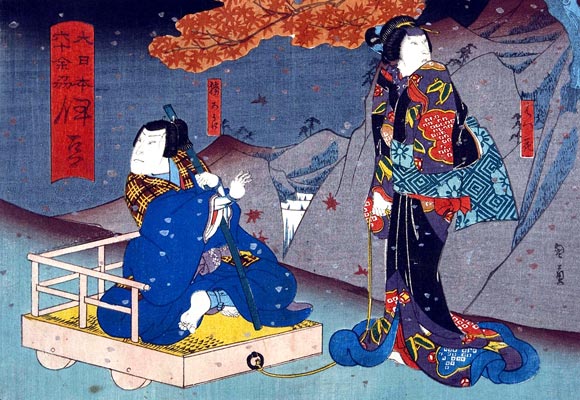| IZARI NO ADAUCHI |
| Play title | Hakone Reigen Izari no Adauchi Z˘ho Izari no Adauchi |
| Authors | Shiba Shis˘ ("Hakone Reigen Izari no Adauchi") Segawa Jok˘ II ("Z˘ho Izari no Adauchi") |
| History |
"Hakone Reigen Izari no Adauchi" was written for the puppet theater and staged in the 8th lunar month of 1801. It was immediately adapted for Kabuki and staged in 9th lunar month of 1801 in Ky˘to at the Kitagawa no Shibai [casting]. It was revised by Segawa Jok˘ II and staged for the first time in Edo, in the 7th lunar month of 1808 at the Nakamuraza [casting]. The title of this revision was "Z˘ho Izari no Adauchi". This play was based on a real event: the revenge of Iinuma Hatsugor˘, who killed Kat˘ K˘suke, the murderer of Hatsugor˘'s brother, the 21st of January 1590. |
| Structure |
"Hakone Reigen Izari no Adauchi" was originally made up of 12 acts. The 11th act, which is made up of two scenes, is still part of the current Kabuki repertoire. The first scene, the "Amidaji Temple", lasts between 60 and 70 minutes. The second scene, "the Shirataki Waterfall", lasts less than 20 minutes. |
| Key words | Gidayű Ky˘gen Jidaimono Adauchi Reigenkimono |
| Summary |
What has happened before the opening of the curtain Iinuma Sanpei, the elder brother of Iinuma Katsugor˘, was killed by the villain Sat˘ G˘suke. Katsugor˘ has sowrn to take revenge and kill G˘suke. His long quest led him to the mansion of Tsukumo Shinzaemon, where he became retainer and fell in love with Shinzaemon's daughter Hatsuhana. Shinzaemon agreed to their wedding and the newly-weds decided to run together after G˘suke, disguised as a couple of beggars. They were helped by Fudesuke, the brother of Hatsuhana. Katsugor˘ fell ill on the road and unfortunately lost the use of his legs. At the Amidaji temple in the mountains of Hakone Katsugor˘ is crippled and Hatsuhana pulls him along in a wooden cart. They walk a long way to Hakone, where lives their enemy, who has changed his name to Takiguchi K˘zuke and has joined the H˘j˘ clan. They confront their mortal enemy in the Temple of Amidaji, where beggars can receive alms from the H˘j˘ clan members. He captures Hatsuhana's mother Sawarabi and takes pleasure in humiliating Katsugor˘. Katsugor˘, who has suffered many years in search of G˘suke, limps out of his cart, seizing the hilt of his katana and looking fiercely at his enemy. The opportunity of revenge has come but the crippled Katsugor˘ is powerless against the villain, whose power is at his peak. G˘suke cooly smokes his pipe at his ease and leisure. Then, he offers a deal to Katsugor˘: he will spare his life if Katsugor˘ gives him his wife Hatsuhana. G˘suke leaves with Hatsuhana. At the Shirataki waterfall in the mountains of Hakone Hatsuhana returns and goes to the sacred waterfall of T˘-no-Zawa, where she prays within the extremely cold water for the recovery of her husband. By some miracle, Hatsuhana's prayers are answered and Katsugor˘ suddenly recovers the use of his legs, while Hatsuhana mysteriously vanishes! Fudesuke arrives at the scene of the miracle, bringing with him the head of Hatsuhana, who has resisted G˘suke's will and was beheaded by the villain. Everybody understands that the woman who prayed in the waterfall was none other than the ghost of the faithful Hatsuhana. What will happen after the closing of the curtain Katsugor˘ and Fudesuke win out over G˘suke, avenging the murders of Katsugor˘'s brothers Sanpei and Katsugor˘'s wife Hatsuhana. |
 |
|
The actors Nakamura Tamashichi I and Nakamura Kanjaku II portraying Iinuma Katsugor˘ and Hatsuhana in the drama "Hakone Reigen Izari no Adauchi" in a mitate-e print made in 1861 by Utagawa Kunikazu |
|
|
| Contact | Main | Top | Updates | Actors | Plays | Playwrights | Programs | Links | FAQ | Glossary | Chronology | Illustrations | Prints | Characters | Derivatives | Theaters | Coming soon | News |